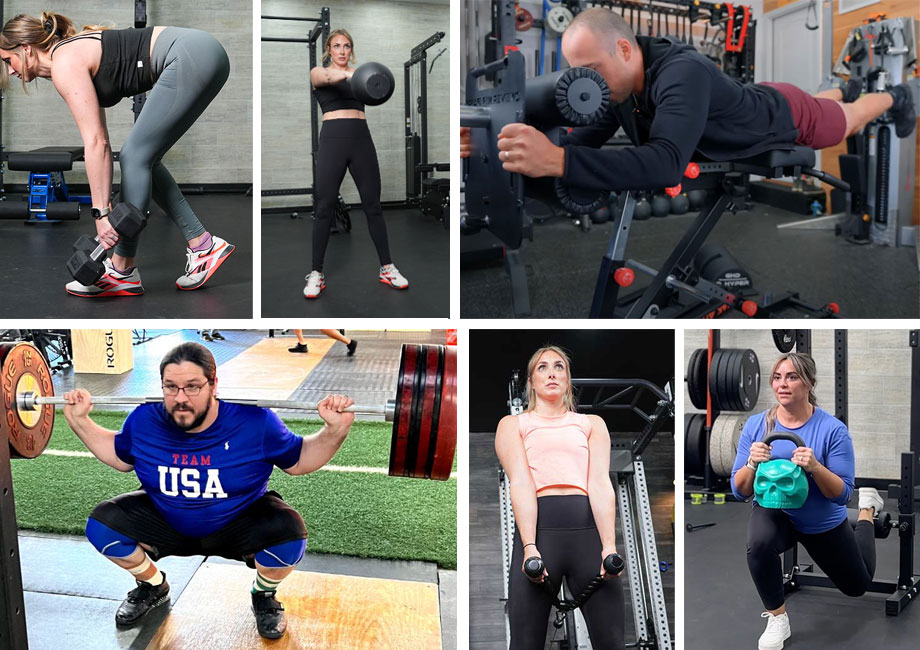We test and review fitness products based on an independent, multi-point methodology. If you use our links to purchase something, we may earn a commission. Read our disclosures.
If you’ve ever tried a hip thrust workout, you’ll understand why the hip thrust exercise is so popular. Not only does it hit the gluteal muscles, hamstrings, lower back, and quads, but a 2019 Journal of Sports Science and Medicine1 systematic review found that it presents greater activation of the hip extensor muscles compared to more conventional exercises.
That said, it’s a great idea to know alternative exercises. The equipment you require might not be available, or hip thrusts may continue to cause you back pain regardless of how you modify them. Alternatively, you may just want more variety in your workout routine.
I’m here to share 11 barbell hip thrust alternatives, their benefits, and how to do them step-by-step. Next, I’ll go through three sample hip thrust alternative workouts that I would recommend to clients as a certified personal trainer (CPT). I’ve been doing these exercises for the past 10 years, so rest assured that you’re in good hands. Let’s get started!
11 Best Hip Thrust Alternatives
- Barbell Back Squat
- Cable Pull-Through
- Step-Up
- Sumo Deadlift
- Split-Stance Romanian Deadlift
- Bulgarian Split Squat
- Kettlebell Swing
- Single-Leg Glute Bridge
- Cable Kickback
- Hyperextension
- Reverse Hyperextension
Barbell Back Squat
Muscles worked: Quadriceps, hamstrings, glutes, calves, lower back, core
Benefits: Although a 2021 Journal of Strength and Conditioning Research2 study found increased activation of the gluteus maximus during barbell hip thrusts compared to back squats, this doesn’t tell the whole story. Squats are the king (or queen!) of lower-body exercises and are superior for building muscle in the quads, hamstrings, calves, lower back, and core.
How to do it:
- Adjust the J-hooks on a squat or power rack so the bar is at shoulder height.
- Add our preferred weight plates to the barbell.
- Step underneath the bar, resting it on your upper back. Your feet should be hip-width apart, and your hands placed on the bar, slightly wider than shoulder-width apart.
- Unrack the bar, then take a couple of steps backward. Adjust your feet if necessary.
- Brace your core, squeeze your glutes, and squat down.
- Continue until your quads are at least parallel to the floor. Pause momentarily.
- Push through your feet to return to the standing position.
- Repeat for reps.
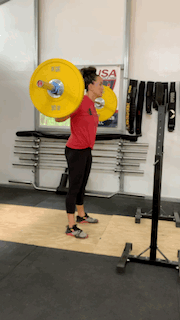
Modifications
- Dial it back: Try goblet squats by holding a single dumbbell or kettlebell in front of your chest. If you have knee problems such as meniscus tears, front squats may be more beneficial than back squats, as shown in a 2009 Journal of Strength and Conditioning Research3 study.
- Make it harder: Pause and tempo back squats are two progressions. Pause in the bottom position for two or three seconds for the former. The latter increases time under tension (TUT) because the downward (aka eccentric) movement is slower.
RELATED: Front Squat Vs Back Squat
Cable Pull-Through
Muscles worked: Hamstrings, glutes, lower back, core
Benefits: For beginners—or those uncomfortable training with free weights—cable pull-throughs work the same muscle groups as hip thrusts. The cables are also safer because their movement is fluid and more efficient since you can use the pin to change the weight in seconds.
How to do it:
- Fix a rope attachment to a cable machine and set the pulley at the bottom and select your desired weight.
- Hold the attachment with a neutral grip (palms facing each other) between your legs. You should be facing away from the cables and your feet should be slightly wider than hip-width apart.
- Tense your core, and then move the rope closer to the cable machine by driving your hips backward.
- Hold when you can’t lower any further.
- Reverse the motion to return to the original position.
- Continue for the desired number of reps.
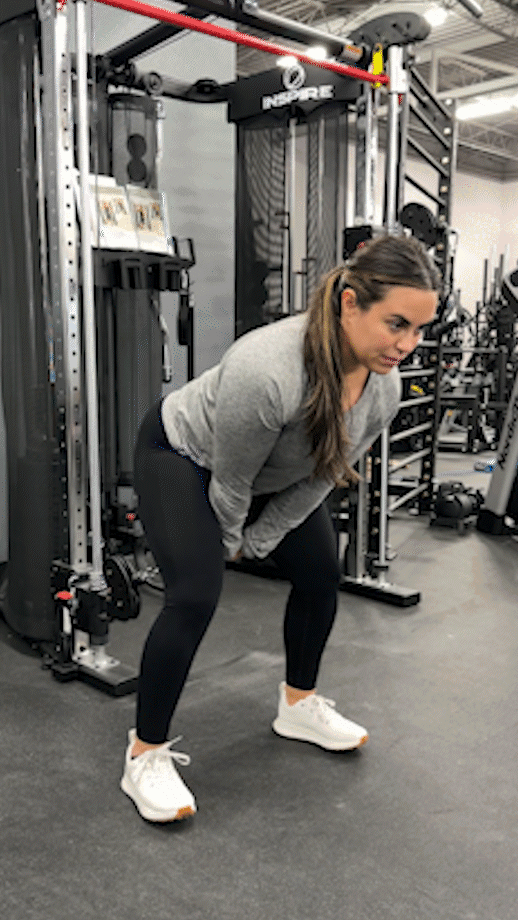
Step-Up
Muscles worked: Quadriceps, hamstrings, glutes, calves, lower back, core
Benefits: According to a 2020 Journal of Sports Science and Medicine4 systematic review, several bilateral exercises (which include hip thrusts) can provide very high levels of glute activation. However, “the step-up exercise and its variations present the highest levels,” which is why it’s a fantastic alternative to hip thrusts.
How to do it:
- Stand upright with a flat bench, one of the best plyo boxes, or a similar sturdy platform in front of you. Your feet should be hip-width apart.
- Step your left foot onto the platform so your left leg is bent at a 90-degree angle.
- Shift some of your body weight to the left side while simultaneously stepping your right foot onto the surface.
- Stand tall on the platform and pause.
- Lower yourself down by stepping off the platform. You’ll want to lead with the left leg.
- Repeat for reps, then replicate with the right foot.
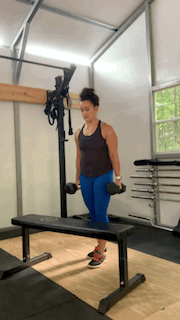
Modifications
- Dial it back: Make the step-up exercise easier by reducing the height or lowering the number of reps you perform on each side.
- Make it harder: You can make step-ups more challenging by holding a dumbbell or kettlebell in each hand. Other options include increasing the height of the platform or lifting your back leg into a high knee on each repetition.
Sumo Deadlift
Muscles worked: Hamstrings, glutes, quadriceps, calves, lower back, core
Benefits: Sumo deadlifts activate the lower-body posterior chain muscles, similar to hip thrusts. They allow you to lift heavy weights and don’t require a flat bench. A 2019 study5 in the Journal of Sports Science and Medicine found that sumo deadlifts might be slightly mechanically advantageous for individuals with longer torsos compared to conventional deadlifts.
How to do it:
- Place a loaded barbell on the ground.
- Step underneath the bar with your feet around two times your shoulder width (so wider than a traditional deadlift). You’ll want the bar close to your shins.
- Squat down toward the bar.
- Grasp the bar with a double overhand (palms facing the floor) or mixed grip. Your arms and hands must be inside your legs.
- Engage your core, retract your shoulder blades, and then lift the bar off the floor by driving through your feet.
- Squeeze your glutes as you stand up. The bar will end near your pelvic region.
- Pause before returning the bar to the floor in a controlled manner.
- Repeat for reps.
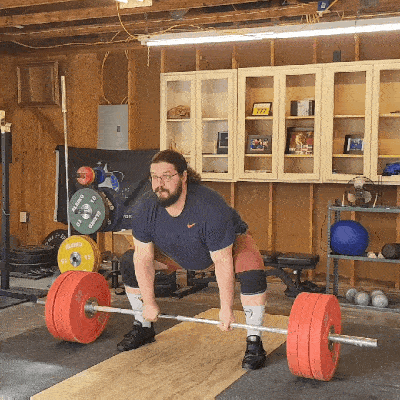
Modifications
- Dial it back: Resistance band sumo deadlifts are one alternative for those with previous injuries or those uncomfortable training with barbells. You can also do sumo deadlifts using one or two kettlebells or dumbbells.
- Make it harder: Stand on a weight plate or raised platform to do sumo deadlifts from a deficit to increase the range of motion. Or, consider sumo deadlift high pulls if you want to hit your upper back, shoulders, and arms simultaneously.
RELATED: Best Resistance Bands
Split-Stance Romanian Deadlift
Muscles worked: Hamstrings, glutes, lower back, core
Benefits: The benefit of doing split-stance Romanian deadlifts over hip thrusts is that you work each side of the body separately, helping to fix muscular imbalances and address bilateral deficits6. Technically, you could do single-leg hip thrusts and get the same benefits, but I like that Romanian deadlifts emphasize the hamstring muscles and lower back.
How to do it:
- Stand tall with a pair of dumbbells in your hands. Your arms should be at your sides.
- Lift your right foot off the floor and place your right toes on the ground behind you. Your left foot should remain fixed in place.
- Tense your core, keep your head neutral, and push your hips back so your chest moves toward the ground.
- Hold momentarily when the dumbbells reach your shins.
- Drive through your left foot to return to the starting position.
- Keep going for the desired number of reps.
- Repeat the exercise on the opposite side.
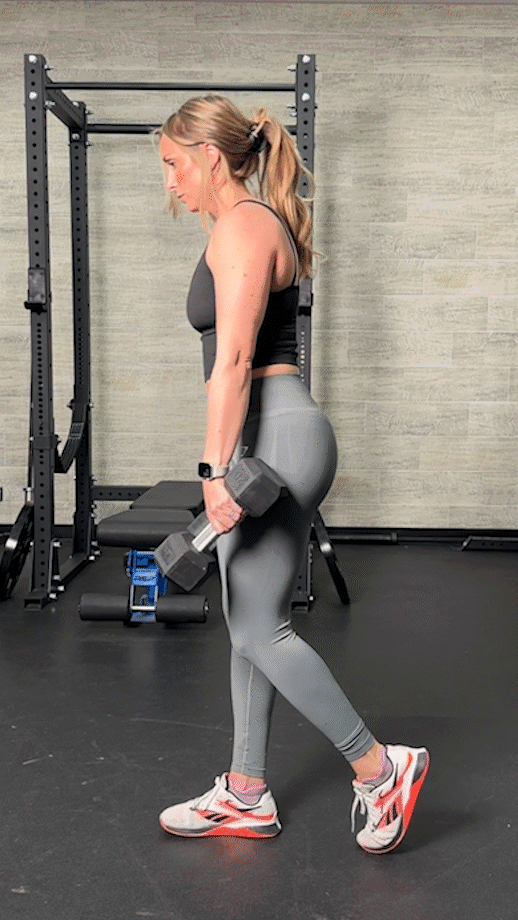
Modifications
- Dial it back: Do regular dumbbell or barbell Romanian deadlifts to learn the movement pattern before progressing to the split-stance version. You can also use a lighter weight, or no weight.
- Make it harder: Instead of dumbbells, use a barbell. You can increase the load you lift or perform from a deficit. Alternatively, try single-leg Romanian deadlifts because these will improve your balance and stability more than split-stance Romanian deadlifts.
RELATED: Single-Leg Deadlift
Bulgarian Split Squat
Muscles worked: Quadriceps, hamstrings, glutes, calves, lower back, core
Benefits: Bulgarian split squats are challenging with just your body weight, which is why I love them. You don’t need as much equipment as you do with hip thrusts and can do them anywhere. Like the split-stance Romanian deadlifts above, they’re a unilateral exercise and will help improve your balance and coordination.
How to do it:
- Stand tall with a flat bench, plyometric box, or a similar sturdy object behind you.
- Place the upper half of your left foot on the elevated surface while keeping your right foot fixed on the ground.
- Bend your right knee to begin lowering toward the ground. You’ll want to keep your core engaged and your arms by your sides.
- Continue until your right quad is parallel to the floor. Pause.
- Push through your right foot to return to the upright position.
- Repeat for reps before switching to the other side.
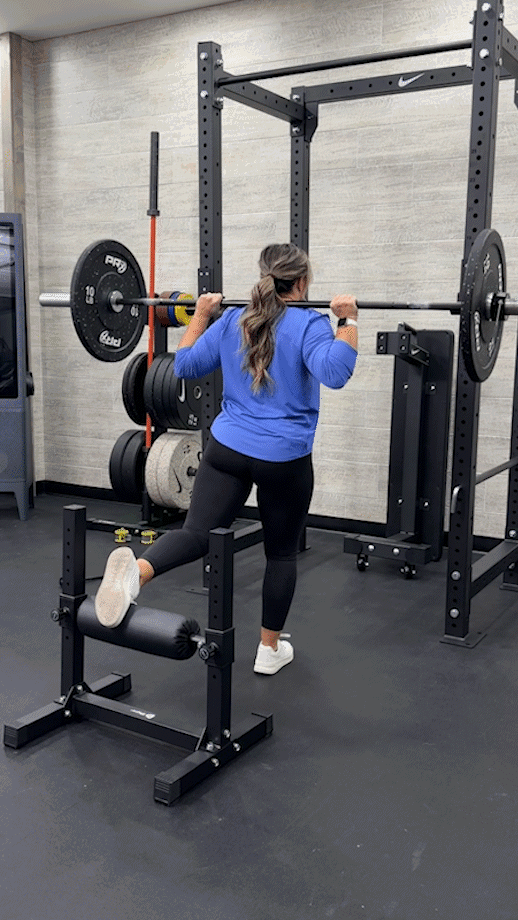
Modifications
- Dial it back: Try standard split squats instead of Bulgarian split squats. With the former, the only difference is you don’t elevate your rear leg. You can also do any lunge exercise, such as standard lunges, reverse lunges, walking lunges, and more.
- Make it harder: You can increase your difficulty by adding resistance in the form of a barbell, a kettlebell, or a pair of dumbbells. Adding tempos and pauses is another option, similar to what you saw with barbell back squats above.
Kettlebell Swing
Muscles worked: Hamstrings, glutes, quadriceps, calves, lower back, core, back muscles, shoulders
Benefits: Kettlebell swings are unique because they work your upper and lower-body posterior chain muscles simultaneously, whereas hip thrusts focus on the lower body. Because of this, many individuals credit kettlebell swings with restoring and enhancing back health and function, as found in a 2012 study7 in the Journal of Strength and Conditioning Research.
How to do it:
- Stand upright, holding a single kettlebell with an overhand grip (palms facing the floor). Your feet should be hip-width apart and the kettlebell should be at your pelvic region.
- Brace your core, squeeze your glutes, and bend your knees slightly.
- Drive your hips back so the kettlebell moves toward the ground.
- Swing the kettlebell toward the ceiling by thrusting your hips forward.
- Pause when the kettlebell reaches chest height (if you’re doing the Russian kettlebell swing) or the overhead position (for the American kettlebell swing). Your arms should be in a straight line for both.
- Return to the starting position by swinging the kettlebell back and through your legs doing a hip hinge.
- Repeat for reps.
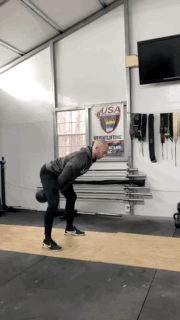
Modifications
- Dial it back: To improve your hip extension, beginners should do Romanian deadlifts before performing kettlebell swings. You can even do these with kettlebells to practice working with them.
- Make it harder: You can perform single-arm kettlebell swings by holding the kettlebell with one hand for the entire set before switching sides. Or, try alternating kettlebell swings, where you swap hands at the top of the movement on each rep.
RELATED: Posterior Chain Exercises
Single-Leg Glute Bridge
Muscles worked: Glutes, hamstrings, lower back, core
Benefits: Although glute bridges and hip thrusts look similar, there are subtle differences. With glute bridges, your upper back is on the floor, not a flat bench. Place a dumbbell or kettlebell on your lap to add weight to the glute bridge without loading a barbell. Therefore, single-leg glute bridges are a beginner-friendly alternative that works the same muscles as hip thrusts.
How to do it:
- Lie down on the floor or on one of the best exercise mats. You’ll want to face the ceiling.
- Place your feet flat on the ground by bending your knees.
- Position your arms at your sides, ensuring that they’re extended.
- Lift your left foot off the floor and straighten your left leg towards the ceiling. Your right foot should remain fixed.
- Squeeze your glute muscles and engage your core.
- Push your right foot into the ground while simultaneously lifting your hips towards the ceiling.
- Hold momentarily before returning your hips to the floor.
- Continue for reps before swapping sides.
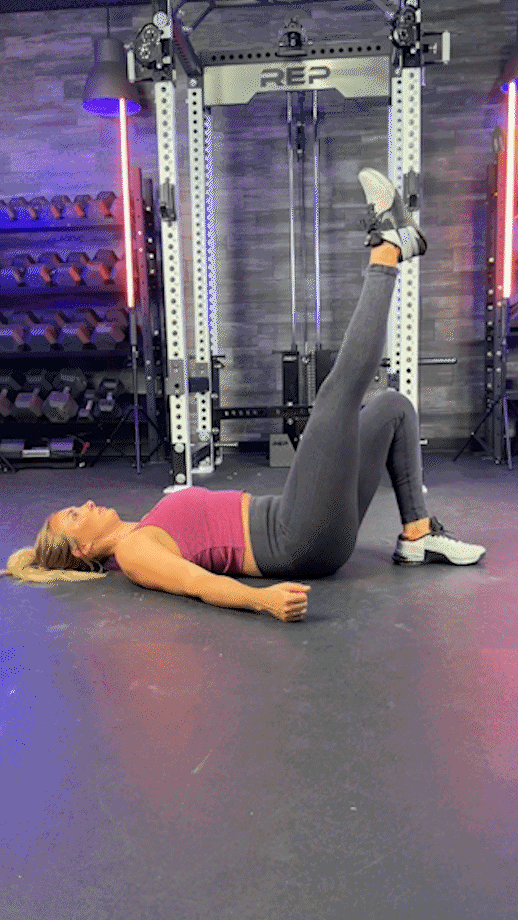
Modifications
- Dial it back: Instead of doing this lower-body exercise unilaterally, perform regular glute bridges until you’re comfortable. Although this won’t help fix muscular imbalances, it’s easier than single-leg glute bridges.
- Make it harder: The simplest way to increase your difficulty is to place a single dumbbell or kettlebell on your lap before doing the exercise. You can also pause for a longer duration at the top.
Cable Kickback
Muscles worked: Glutes, hamstrings, lower back, core
Benefits: You saw the benefits of using a cable machine with cable pull-throughs above, and the same benefits apply here. You work each leg separately, which can help correct muscular imbalances.
How to do it:
- Fix an ankle strap attachment to a cable machine, and set the pulley to its lowest position.
- Loop the attachment around your left ankle while standing upright.
- Hold the cable machine with both hands to help with stability.
- Bend your right knee slightly and shift some of your body weight to the right-hand side. You can lift your left foot off the ground slightly if it helps.
- Kick your left leg toward the ceiling behind you. Pause at the top.
- Bring your left leg back to its original position.
- Kick back for reps before repeating the exercise with your right leg.
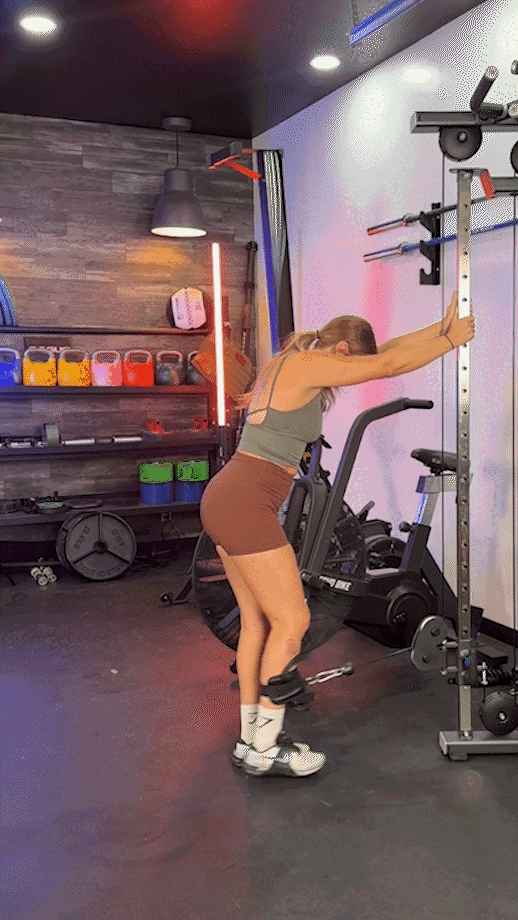
Hyperextension
Muscles worked: Lower back, glutes, hamstrings, core
Benefits: The hyperextension exercise is easy to learn, and you can do a full set in a matter of minutes (it takes this long to set up the equipment on hip thrusts!). Apart from a hyperextension machine, all you need is your body weight. It still, however, hits the same muscle groups as hip thrusts.
How to do it:
- Adjust a hyperextension machine so that the back of your ankles are secure underneath the foot pads. Both feet should be firmly pressed against the platform, and your quads should rest against the thigh pads.
- Clasp your hands behind your head, or cross your arms over your chest.
- Tense your core and glutes before slowly lowering your upper body toward the floor. This is the starting position.
- Lift your upper body toward the ceiling so there’s a straight line from head to toe.
- Lower back down toward the ground in a controlled manner.
- Repeat for reps.
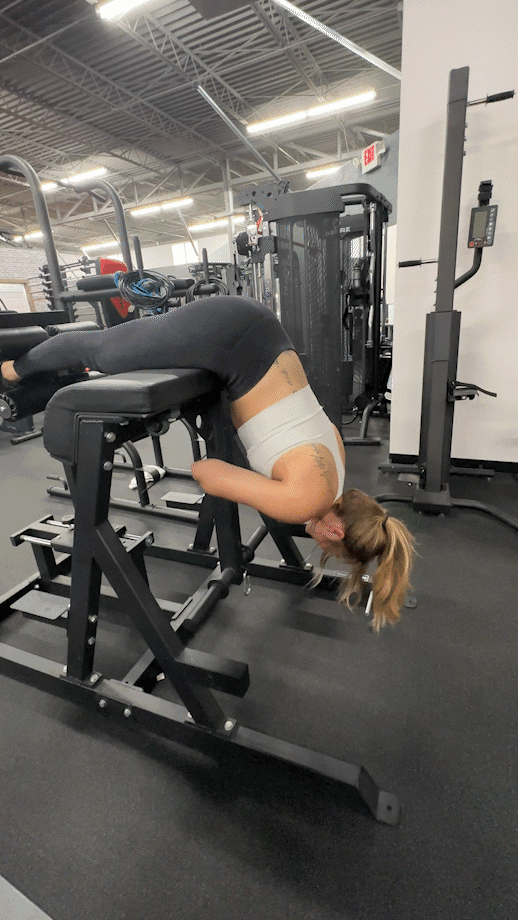
Modifications
- Dial it back: If you don’t have a hyperextension machine or need an easier variation, do floor hyperextensions. Placing a dumbbell or weight plate between your feet increases the intensity slightly.
- Make it harder: Holding a weight plate, dumbbell, or kettlebell across your chest is the most effective way to make the exercise harder. If you do this, ensure that you’re still doing the exercise with proper form to avoid injury.
Reverse Hyperextension
Muscles worked: Lower back, glutes, hamstrings, core
Benefits: The difference between hyperextensions and reverse hyperextensions is that the latter may be better regarding muscle growth and strength in the posterior chain muscles. A 2021 Journal of Strength and Conditioning Research study8 concurs, although it’s worth noting that regular hyperextensions are a more popular exercise.
How to do it:
- Lie on a flat bench, glute-ham developer (GHD) machine, or a hyperextension machine. You’ll want to face the floor, with your legs hanging off the end so you can move them.
- Squeeze your glutes and brace your core.
- Raise your legs toward the ceiling behind you, ensuring that they’re straight throughout.
- Continue until your legs are at least above your hips. Pause.
- Reverse the motion to return to the starting position.
- Keep going for reps.
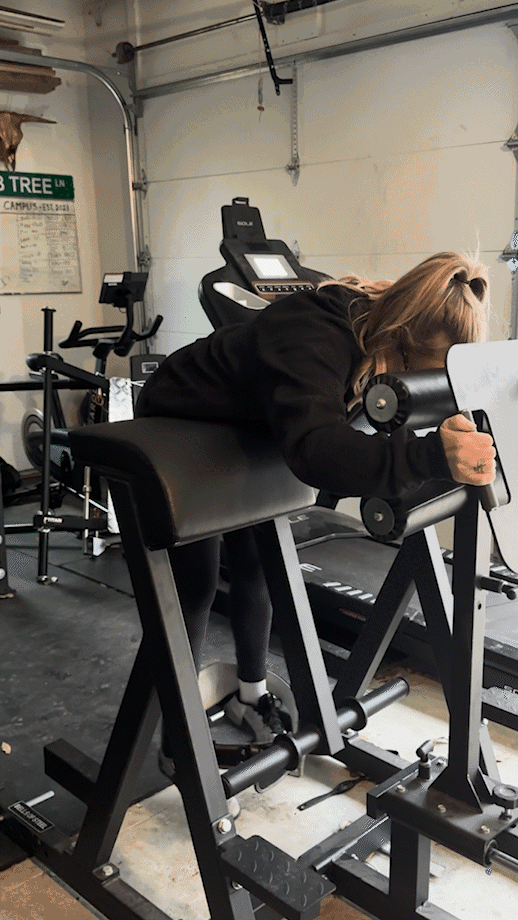
Modifications
- Dial it back: Try different machines to see what is easiest for you. You can also reduce your number of repetitions.
- Make it harder: You can place a dumbbell between your feet to increase the difficulty of the exercise. Another great exercise is the reverse hyperextension isometric hold, where you hold the top position for a specific duration of time.
RELATED: Best Glute Machines
Sample Hip Thrust Alternative Workouts
Before starting the exercises above, check out these three sample hip thrust alternative workouts I recommend to clients. One is for beginners, one is to gain muscle (aka hypertrophy), and the final is for muscular endurance. See below:
Hip Thrust Alternative Workout For Beginners
For beginners, I’ve included four exercises for a total of 10 sets. You’ll want to rest for roughly one minute between each set. If bodyweight step-ups, hyperextensions, and single-leg glute bridges become too easy, add resistance in the form of dumbbells, kettlebells, weight plates, or resistance bands.
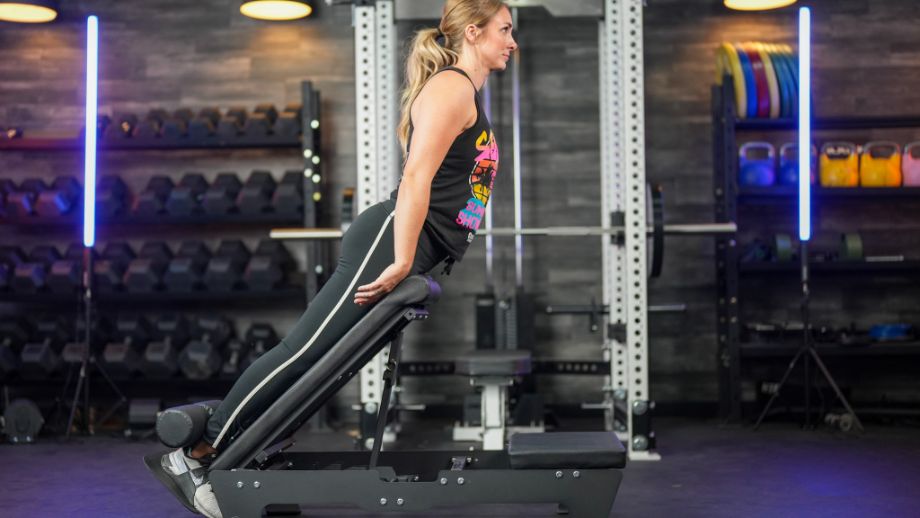
To warm up, do a few minutes of cardio, then perform dynamic exercises such as jumping jacks, bodyweight squats, inchworms, leg swings, and more.
| Exercise | Sets | Reps |
| Step-Up | 3 | 8, each side |
| Hyperextension | 3 | 10 |
| Single-Leg Glute Bridge | 2 | 10, each side |
| Cable Pull-Through | 2 | 12 |
Equipment needed: A flat bench or plyometric box, a hyperextension machine, and a cable machine or resistance band
Hip Thrust Alternative Workout For Hypertrophy
Gaining muscle requires increasing your number of exercises and sets. The exercises will also be more intense because you’ll train with barbells and body weight, meaning you’ll need around two to three minutes of rest between each set, especially for barbell back squats and sumo deadlifts.
Warm up by doing a few minutes of cardio and dynamic exercises like those above. You’ll also want to perform some lighter sets on the first two exercises before lifting heavy weights.
| Exercise | Sets | Reps |
| Barbell Back Squat | 4 | 6 |
| Sumo Deadlift | 3 | 8 |
| Bulgarian Split Squat | 3 | 10, each side |
| Cable Kickback | 3 | 10, each side |
| Reverse Hyperextension | 3 | 12 |
Equipment needed: A squat or power rack, a barbell and weight plates, a flat bench or plyometric box, a cable machine with an ankle strap attachment or resistance band, and a hyperextension machine
Hip Thrust Alternative Workout For Muscular Endurance
For muscular endurance, the number of reps for each set will be higher than what you saw with the hypertrophy workout above. The load you lift will be lighter (between 40% and 60% of your one-rep max), and your rest times will be shorter (between 30 and 60 seconds). You’ll do 12 sets in total.
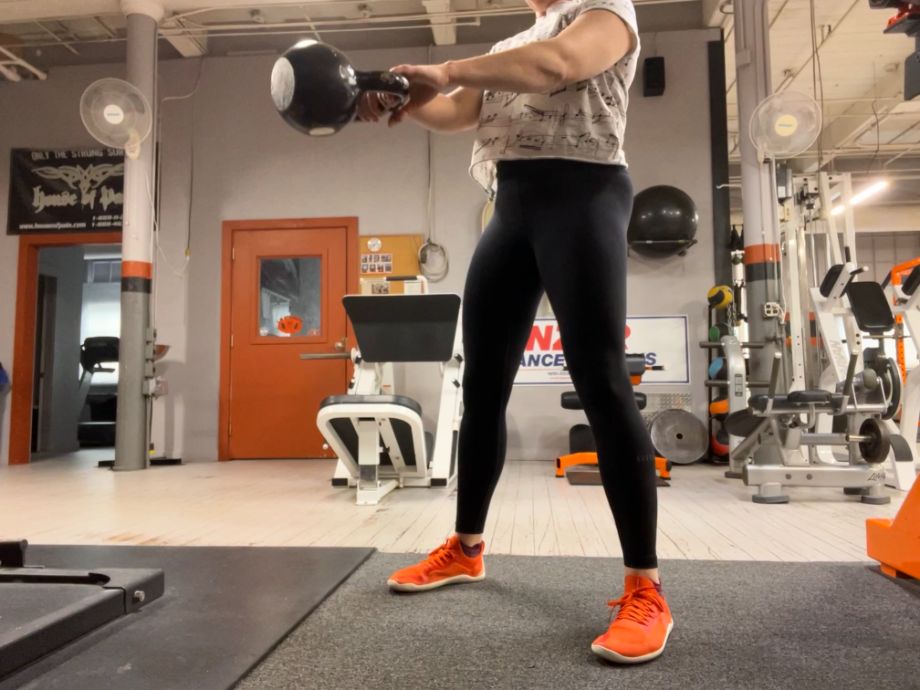
Again, do a warm-up consisting of cardio and dynamic exercises.
| Exercise | Sets | Reps |
| Kettlebell Swing | 3 | 15 |
| Split-Stance Romanian Deadlift | 3 | 15, each side |
| Step-Up | 3 | 20, each side |
| Hyperextension | 3 | 20 |
Equipment needed: A kettlebell, a pair of dumbbells, a flat bench or plyometric box, and a hyperextension machine
Benefits of Hip Thrust Alternatives
Why do you need hip thrust alternatives in the first place? The correct equipment may not be readily available, hip thrusts could be causing you back pain, or you may want to add more variety to your training.
Helps When Equipment Is Unavailable
The downside to hip thrusts is that they occasionally require a barbell, weight plates, and a flat bench. Setting this up can take time, and you can’t guarantee that all the equipment will be available when needed. Some hip thrust alternatives only require your body weight, whereas others need one piece of equipment, such as a kettlebell or a flat bench. Instead of waiting for equipment to become available, do an alternative exercise.
Helps Reduce Back Pain
When clients tell me that hip thrusts aggravate their back—particularly their lower back—I try to adjust their starting position and form first. If that doesn’t help, I’ll have them switch to an alternative exercise, and the back pain tends to disappear.
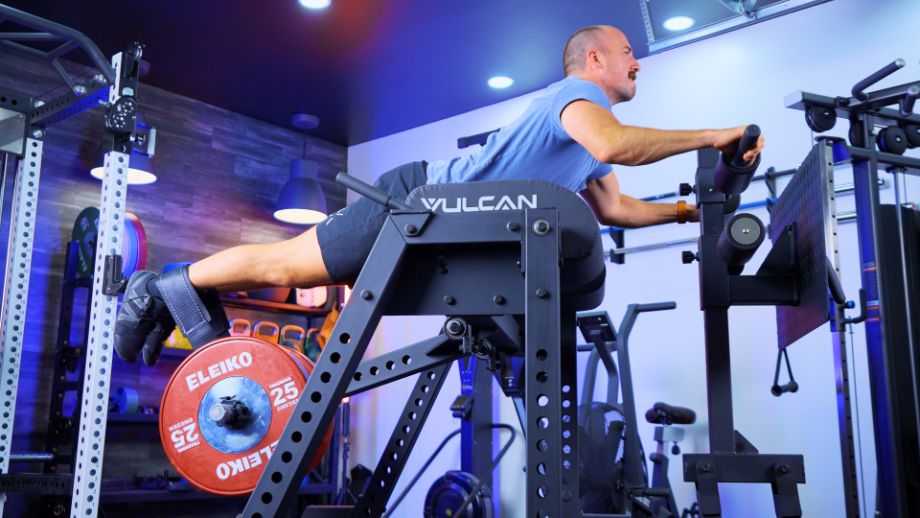
Adds Variety To Your Training
As the popular saying goes, variety is the spice of life. I have nothing against barbell hip thrusts and do them regularly—along with other hip thrust variations. However, sometimes I don’t feel like doing them or want to hit the muscles worked by hip thrusts in a slightly different way. This is where knowing how to do hip thrust alternatives comes in useful.
Hip Thrust Alternatives: Final Thoughts
There are several reasons why you might be looking for hip thrust alternatives. The equipment you need may not be available, hip thrusts may be causing you back pain, or you might simply want to add more variety to your workout routine.
Regardless of your reasons, try all the above hip thrust alternatives to see which works for you and which doesn’t. When you find the three or four exercises you enjoy, do them consistently to build your posterior chain muscles.
Hip Thrust Alternatives: FAQs
Can you build glutes without hip thrusts?
Yes, you can build glutes without hip thrusts. Some of the best glute exercises that are alternatives to hip thrusts include:
-Barbell back squat
-Cable pull-through
-Step-up
-Sumo deadlift
-Split-stance Romanian deadlift
-Bulgarian split squat
-Kettlebell swing
-Single-leg glute bridge
-Cable kickback
-Hyperextension
-Reverse hyperextension
Every individual has different preferences, so try them all to see what you like. I enjoy barbell back squats, sumo deadlifts, and hyperextensions.
Can you do hip thrust without equipment?
If you don’t have any equipment, you can still do bodyweight hip thrusts and bodyweight single-leg hip thrusts. However, you may soon get to the point where you find both exercises too easy, so you’ll need to add some resistance. Resistance bands are a more affordable option than barbells and dumbbells, so consider looking into these first.
RELATED: Resistance Bands For Glutes
Are hip thrusts or RDLs better?
Both hip thrusts and RDLs are fantastic exercises, so I can’t say one is better. From my experience as a certified personal trainer (CPT), I’ve found that hip thrusts work the glutes better than RDLs, whereas RDLs hit the hamstrings and lower back to a greater extent. Therefore, the better exercise depends on the muscle group you’re looking to target.
References
- Neto WK, Vieira TL, Gama EF. Barbell Hip Thrust, Muscular Activation and Performance: A Systematic Review. J Sports Sci Med. 2019 Jun 1;18(2):198-206. PMID: 31191088; PMCID: PMC6544005.
- Williams MJ, Gibson NV, Sorbie GG, Ugbolue UC, Brouner J, Easton C. Activation of the Gluteus Maximus During Performance of the Back Squat, Split Squat, and Barbell Hip Thrust and the Relationship With Maximal Sprinting. J Strength Cond Res. 2021 Jan 1;35(1):16-24. doi: 10.1519/JSC.0000000000002651. PMID: 33332802.
- Gullett JC, Tillman MD, Gutierrez GM, Chow JW. A biomechanical comparison of back and front squats in healthy trained individuals. J Strength Cond Res. 2009 Jan;23(1):284-92. doi: 10.1519/JSC.0b013e31818546bb. PMID: 19002072.
- Neto WK, Soares EG, Vieira TL, Aguiar R, Chola TA, Sampaio VL, Gama EF. Gluteus Maximus Activation during Common Strength and Hypertrophy Exercises: A Systematic Review. J Sports Sci Med. 2020 Feb 24;19(1):195-203. PMID: 32132843; PMCID: PMC7039033.
- Cholewa JM, Atalag O, Zinchenko A, Johnson K, Henselmans M. Anthropometrical Determinants of Deadlift Variant Performance. J Sports Sci Med. 2019 Aug 1;18(3):448-453. PMID: 31427866; PMCID: PMC6683626.
- Škarabot J, Cronin N, Strojnik V, Avela J. Bilateral deficit in maximal force production. Eur J Appl Physiol. 2016 Dec;116(11-12):2057-2084. doi: 10.1007/s00421-016-3458-z. Epub 2016 Aug 31. PMID: 27582260.
- McGill SM, Marshall LW. Kettlebell swing, snatch, and bottoms-up carry: back and hip muscle activation, motion, and low back loads. J Strength Cond Res. 2012 Jan;26(1):16-27. doi: 10.1519/JSC.0b013e31823a4063. PMID: 21997449.
- Cuthbert M, Ripley NJ, Suchomel TJ, Alejo R, McMahon JJ, Comfort P. Electromyographical Differences Between the Hyperextension and Reverse-Hyperextension. J Strength Cond Res. 2021 Jun 1;35(6):1477-1483. doi: 10.1519/JSC.0000000000004049. PMID: 34027916.
Further reading

Who needs barbells and dumbbells when they could use resistance bands? Check out our Harambe system review to see if this is a better choice for your home gym. Read more

A registered dietitian has chosen her top nine high-protein low-fat foods that you can incorporate into your diet to help reach your goals. Read more

Looking for a delightful, smooth, protein-packed snack? That’s exactly what you’ll find in this guide to the best protein shakes. Read more

The Rep Fitness Adjustable Bench is one of the best value benches currently available. The Rep Fitness Flat Bench is also a great option at a great price for those looking for a capable bench with a large weight capacity. Read more

